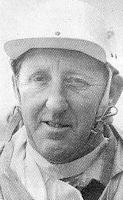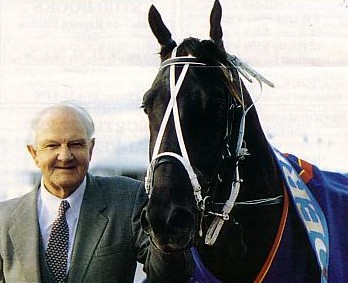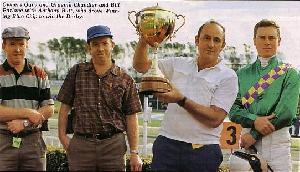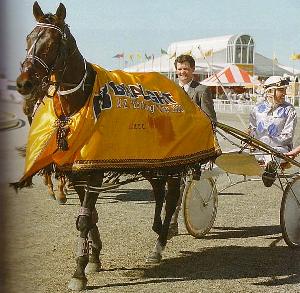| PEOPLE |
YEAR: 2011
 |
There was standing room only om Monday at the funeral service for harness racing identity Henry Skinner who died in Invercargill on June 20, aged 78. He was described in the many tributes as a no fuss horseman with great judgement and practical skills. This was backed by his results.
In a driving career spanning 45 years, from his first drive in the 1956-57 season to his last in the 2000-01 term, Skinner reined the winners of 717 races. Among his major successes were the 1979 Auckland Cup with Sapling, the New Zealand Messenger Stakes in 1976 and 1978 with Forto Prontezza and Sapling, the 1989 New Zealand 2-Year-Old Championship with Honkin Vision and the 1989 Dominion Handicap with Tobago.
He also suffered some near misses suc as when Hi Foyle came up against Young Quinn in the 1975 Inter-Dominion Final, or when Sapling was nutted in both the 1978 New Zealand Cup and the Inter-Dominion Final, or when No Return got clear too late in the 1993 New Zealand Derby. In addition to those second placings in major races, he came close in another New Zealand Cup when Forto Prontezza, a pacer he also trained, came third.
Prior to his entry into harness racing, Skinner had been an apprentice jockey and won his first race at Tapanui in 1948 as a 15-year-old. Among his key wins were the 1949 Invercargill Gold Cup on Gunther, carrying seven stone seven pounds (47.75 kgs) and consecutive Great Western Steeplchases aboard The Denbigh in 1951 and 1952, the latest carrying 11 stone one pound (70.5 kgs). Not long after that, increasing weight led to him swapping saddles for sulkies.
Although it took him 12 seasons to reach his first 100 winners, those were in days when harness racing dates in the south were limited, as were the number of races each day. He topped 30 in a season for the first time with 38 wins in the 1973-74 term and another eight times later. His best tally, of 39, came in 1986-87.
Skinner's solo training career began in 1960 but he netted just the on win in his first term. By the time it ended in 2007, his tally was 327 wins. In addition, a successful five-term partnership with Allan Devery - from 1987 - yielded another 76 wins. Honkin Vision, who won both the 1989 2-year-old Sires' Stakes Final and the 3-year-old version six months later, was their biggest winner.
Skinner was carried into the service to the 1965 Herman's Hermits hit 'I'm Henery the Eigth, I Am' and his daughter Tracey Laker recalled the times he would ring and sing the song down the phone line to her to report on a successful day at the races. She also remembered going to races with him in the days when parking attendants were required, and spoke of the lack of success the white coated brigade had when trying to change her father's parking habits.
Peter Davis, who worked for him for about six years, spoke of the ongoing Skinner influence. Some of the routines he followed, such as when mouthing, Davis said, have stuck with him to this day.
Skinner's casket was draped with the red and white colours he wore so prominently for many years. He is survived by two daughters, Tracey, and Vicky Popham, and five grand-children Morgan, Nic, Georgia, Meg and Flynn.
Credit: Mac Henry writing in HRWeekly 29Jun11
YEAR: 1993
 |
| Roy Purdon and Mark Roy |
A 'rough one' put in by Southland star No return cost him dearly in the John Brandon 30 NZ Derby, but in the end the success of Mark Roy was thoroughly deserved.
"He has thrown a shoe at some stage...probably at the start when he went a bit rough," trainer-driver Henry Skinner lamented later. Beaten out of the gate from the pole, No Return, the dominating favourite going for the Triple Crown, settled three back on the fence and never had an opportunity to get out until after they swung for home. While he flew once into the clear, Mark Roy had a winning break and held him out by a short neck. "I would have been quite happy to keep the front, but it didn't work out that way," said Skinner.
It was shade of deja vu for Skinner, who in 1990 won the first two legs with Honkin Vision. Honkin Vision also went into the Derby a hot favourite, but after attempting to lead all the way, the constant attentions of the Purdon-trained runners in The Unicorn, Mark Hanover and Christopher Vance, saw him fade to fifth. Ironically, that event was the only previous occasion Mark Purdon, the successful driver on Saturday, had driven in the race. He drove Mark Roy's half-brother Mark Hanover, the horse he would win the Auckland Inter-Dominion with the following year, into fourth on that occasion.
The Purdons had three runners engaged also this year, with 28-year-old Mark renewing his association with Mark Roy the previous Saturday after seven weeks on the sideline with a broken arm, a legacy of the sales series smash in mid-February. Elder brother Barry again took the reins on Hitchcock, while Tony Herlihy guided Mister Wolf Blass.
Back early from the outside of the second line, Mark Roy was on the move in the middle stages, following Mark Craig around when the tempo increased noticeably passing the mile. Trapped without cover three wide from the 1400m, Mark Roy was still able to dash clear in the run home and had enough in reserve to fend off the late claim of No Return. He paced the mobile 2600m in 3:16.2, last 800m in 58.4 and 400m in 28. "It might have looked like a tough run, but he relaxed nicely out there. It is better to have them that way than fighting you," said Mark.
Mark had been in charge of Diamond Field and Mister Wolf Blass at Jim Dalgety's West Melton property during their stay, with Barry looking after the bulk of the team at Jeff Whittakers. Mark Roy has in recent weeks been troubled by quarter cracks, but the use of bar shoes and constant treatment has enabled him to keep racing. The Derby was his seventh win from 23 starts, and along with 11 placings, took Mark Roy's stakes talley on to $163,000. Like Mark Hanover, Mark Roy is raced by co-trainer Roy Purdon, Robert and Mrs Janet Reid and the Lorna Reid Syndicate. "Robert was down for the first two nights but did not come back for the Derby. He had no luck at all on the earlier nights," Mark said.
For Roy and Barry it was their second Derby in a row, having won the race last year with Kiwi Scooter. Roy watched the race from the public grandstand and would have done so alone had an old friend in Derek Jones not spotted him. "Roy came over and stood beside me when we won the NZ Cup with Hands Down," recalled Jones. "He wasn't going to bother coming down to the birdcage, but I set the pace for him," he added.
Miss Clevedon, whose first three foals are Mark Hanover (US1:53.4, winner of over $700,000 in NZ), Roy's Advice (2:00.3, 2 NZ wins) and Mark Roy, unfortunately died in 1991 after foaling a colt by New York Motoring. In between those foals, the Noodlum mare left a Vance Hanover filly, now three, which has not shown the same ability as her relatives to this stage. She is however the only filly left by the former open class mare. "Mark Hanover was brilliant right from the start, while this fellow has steadily improved all along," said Mark.
Bee Bee Cee, the second of three Southland-trained runners, enjoyed the trail behind Hitchcock and stuck on well for third in a gap of four lengths. He shaded Mark Craig and Franco's Chef, who both battled well after improving in the middle stages.
Credit: Frank Marrion writing in HRWeekly 15Apr93
YEAR: 1990
 |
| The connections of Winning Blue Chip |
After sitting alone at the back, unfancied Winning Blue Chip came through to win the $175,000 John Brandon 30 New Zealand Derby.
The chunky bay gelding picked off seven tiring rivals to cause the biggest Derby upset since Naval Officer won the classic in 1984 when only five finished. That was the second surprise. The first was the sinking of Honkin Vision, the raging favourite who was beaten, and badly beaten, with less than 200 metres to run. And the third surprise was the remarkable achievement of Winning Blue Chip to demolish Inky Lord's New Zealand age group record of 3:15.1 by pounding out 3:12.2 for a mobile 2600m.
It was a muted audience who saw the scene unfold, because Winning Blue Chip rated in none of the pre-race forecasts and in the Brandon preludes had done nothing to suggest he was in the same league as the favourites. Driver Anthony Butt said: "I always thought he was a bit below the best of them. The only show I had was if they went hard all the way. I knew I had to take all the short cuts. He was not good enough to go around them."
Henry Skinner took Honkin Vision to the front, as the draw said he would. Sweating freely in the warmer conditions, Honkin Vision made play at better than a 2:00 clip, making the pace hard on the others and harder on himself. Said Skinner: "I was starting to get pretty busy at the quarter." No wonder. The horse had cut out his 2400 metres in 2:57.9 and was starting to hang his head. The Unicorn took him easily. He soon came to the end of it, allowing Winning Blue Chip to pick him off 50 metres out and race clear to win by three-quarters of a length.
The winner is trained by Barrie Lilley, who is not a household name in New Zealand harness racing circles. Formerly a freezing worker, Lilley, aged 46, took out a professional trainer's licence two years ago on the death of his father. One of those he started training was a colt by second season sire Bo Scots Blue Chip from Winning Maid, a winning Willie Win mare formerly trained by Murray Rennie.
Bred by Doody Townley and FA and Mrs JM Stakes of Ashburton, Winning Maid was from Locksley Maid, by Young Charles from Jonell, by Garrison Hanover from Mighty Imp, by Dillon Hall. Winning Maid was raced by Bill Parlane and twin brothers Graeme and Gary Chandler, who bred her to Noodlum after winning one race. She produced Mighty Adios to this mating, returned to win another race, then went to Nevele R Stud to produce her classic winner. She is also the dam of a Nero's B B filly and this season was served by Paulsboro.
On times, Winning Blue Chip was no faint hope. He had recorded a best time of 3:17.5 for the distance, and only Seafield Inca had gone quicker. "But although we didn't expect anything like this, his blood has been out for the last couple of weeks and credit must go to the Halswell Clinic vets for the work they have done getting him right," said Parlane. "He just did not fire on the first two nights like I knew he could."
Credit: Mike Grainger writing in HR Weekly
YEAR: 1988
 |
The 1988 NZ Cup could not boast the depth of quality which most others could, but as a 'two-horse war' it was second to none and it showcased and splendidly capped the illustrious career of the greatest stayer of modern times.
The season had started out promising much, but one by one the likes of open class pacers in Ben, Bionic Chance, Emcee, Freightman, Metal Mickey, Rolls Hanover, Rostreiver Hanover, Sir Alba and Sossy dropped out of the picture for one reason or another.
The brilliant Bionic Chance was the one that hurt the most, being very much a Cup winning prospect but a 'last minute' defection - she fractured a pastern during her last workout two days prior to the race. She had won the Hannon that year and would attempt comebacks, but not win another race. And when the dust had settled, 1986 Cup winner Master Mood or Skipper Dale, third in the previous two years, had not raced up to their best form either.
The Cup in 1988 was in fact a sign of things to come, that is the price that would be paid at the 'other end' for poring money into juvenile racing. Billbob, Trident, Bionic Chance, Tuapeka Knight, Hammer and Honkin Vision had been Sires' Stakes 2yo Final winners at that point, while Slugger, Nardinski, Alba's Reign, Race Ruler, Godfrey, Tight Connection and Honkin Vision were winners of the Juvenile Championship within the same timeframe.
Of those fine young performers, only Bionic Chance and Tight Connection made any impression at all on the open class ranks, and even then they were sporadic and fleeting glimpses, and not a lot has changed either. People are drawn to racing and the track by horses they grow to admire, or 'champions.' The promise of a fast buck might entice a bit of investment in the breeding sector, but it does not pull people through the turnstiles, or generate turnover, which is horse racing's lifeblood. People will talk for days about Bonecrusher, Grey Way or Show Gate, or Lord Module and Lyell Creek, but how many could name a Magic Millions winner.
Anyway, Luxury Liner was one of those horses we grew to admire and November 8, 1988, would be his day. He had been runner-up the previous two years, running into one on the day that was just a bit faster (Master Mood) or tougher (Lightning Blue), but one thing would be for sure this time - he would not be a run short.
Luxury Liner had won the previous season's NZ Free-For-All, Auckland Cup (by five lengths), Easter Cup and Inter-Island Challenge Stakes along with an Inter-Dominion heat in Sydney. The four Group 1s and $585,234 in stakes that season saw him voted Horse of the Year, and his form in the spring of his 7-year-old season had also been exemplary, with a Cambridge track record for 2600m mobile of 3:13.5 (MR 1:59.7) indicating he was as good if not better than ever.
Standing in his way was a 10m handicap - the previous Cup winner from any mark had been Humphrey from six yards two decades earlier - and another Vin Knight special in (Our) Maestro, who had won that year's Inter-Dominion at Harold Park as a 4-year-old, but got in off the front as mobiles didn't count for handicaps at that point. Maestro had won 27 of 35 races and was coming off a win in the Maryborough Cup, where he started from 30 metres in downing Quite Famous, Jim O'Sullivan's 'second string' 8-year-old Cup contender when a 6-year-old (My) Lightning Blue was in a bit of a form slump.
Gina Rosa was a 6-year-old and the best mare around at the time, and she was favoured to place at least after a stout third behind Master Mood in the Ashburton Flying Stakes, while a 5-year-old Speedy Cheval was also at the top of his game, having beaten Skipper Dale and Master Mood at Forbury Park and been second at Kaikoura for new trainer Peter Ryder and owner Ron Annear. Outside the aforementioned, the only other starter given a chance was Lord Lenny, who was in good form that season for Owen Purdon with two wins at Alexandra Park over Luxury Liner.
Despite flight delays which saw the Vitorian pair arrive on the Monday morning prior to Tuesday's Cup, Knight and O'Sullivan were both "brimming with confidence." Knight had worked Maestro prior to the Kilmore Cup at that track over two miles in a 2:00 mile rate, last mile in 1:57 and half in 56, and the 5-year-old son of Gaines Minbar, bought as an unraced 2-year-old from Bryce Buchanan in Southland, had already been handed a Miracle Mile invitation. Quite Famous had also won over $500,000 and his 40 wins had included a Consolation of the 1987 Inter-Dominions at Addington after not being right in the heats. He had gone on a winning spree in the interim and O'Sullivan was sure he was "better than ever." Quite Famous was a good horse, but he was not up to being driven on a big track like Lightning Blue, a distinction he was far from alone in of course.
THE RACE
Several lead changes through the first mile meant that this Cup was not going to be one for the faint-hearted. Skipper Dale showed out first before Gina Rosa, Lord Lenny and Elmer Gantry took over in quick succession, and then the 'battleships' Luxury Liner and Master Mood arrived to ensure there would be no breathers during the remaining mile either. All the while Knight sat in midfield on the outer like a black cat - about to pounce. No sooner had Luxury Liner found the front with Master Mood in close attendance a lap out, than Quite Famous attacked three-wide.
Lord Lenny was the first to feel this relentless pressure in the backstraight, allowing a by now struggling Master Mood to drop onto the fence. At precisely the same point at the 600m, Knight unleashed Maestro and he whistled by Quite Famous four-wide and at such speed that his momentum carried him to a length lead over Luxury Liner turning for home. But Knight had gone for the doctor 200 metres too soon and just as Maestro started to battle at the furlong, an unflustered Tony Herlihy went for Luxury Liner. "When Maestro went past me I was still confident," said Herlihy later. "I had not hit him and didn't think it would be hard to win - just tougher. He is a tremendous stayer and you have got to wind him up."
Luxury Liner came clear to win by almost two lengths in the end, and as if the spectacle had not been enough, an applauding crowd was stunned into silence when the time was posted. Luxury Liner had recorded 4:00.4 when the previous race record had been Lightning Blue's 4:05.1 and the National record 4:04.8, set by Luxury Liner in winning the Thames Cup from 30 metres two years earlier. Four minutes for two miles from a stand was just not heard of, it had not even been contemplated as possible, even on a fine, still Christchurch day with $375,000 at stake ($400,000 for the first time from 1989).
Luxury Liner was a top horse at any time for several seasons, but over the extreme distance he 'grew another leg' and became a great horse, and pretty much unbeatable on his day. When he won a second Auckland Cup seven weeks later, from 15 metres in 4:03.8, it took his 3200m record to 10 starts for seven wins and three seconds - those defeats coming in two NZ Cups and a Franklin Cup from 30m.
The NZ Cup had made Luxury Liner the first millionaire racing in NZ alone, joining Cardigan Bay along with Bonecrusher, Empire Rose and Poetic Prince as millionaire racehorses bred in New Zealand. When retired after one start as a spring 9-year-old, Luxury Liner had won 37 of 86 races and $1,721,984, when Master Mood was the next highest stake-winning NZ-bred standardbred in Australasia with $806,925.
In the aftermath, Knight blamed the journey over for his horse being beaten, rather than conceding his drive and a better horse may have had more to do with it. "He went a bit too quick when he went. He put a good length on Luxury Liner, then came back to me. My horse stopped. He had a couple of hard runs before he came over and then had a fourteen-hour trip. He didn't feel all that good in his prelim...he felt like an old cow." Skipper Dale's driver Pat O'Reilly jnr summed up the thoughts of the remaining drivers when he said..."It was too much for him - the speed they were going."
For 30-year-old Herlihy, previously unplaced twice with Comedy Lad and second the year before - Brent Mangos was Luxury Liner's regular pilot until the start of his 6-year-old season - Luxury Liner was the first of three NZ Cups within six years. He would also score with the Purdon-trained millionaires in Christopher Vance(91) and Chokin(93), while his seven Auckland Cups to date is one more than Peter Wolfenden.
Luxury Liner was by Mercedes, one of the first sons of Meadow Skipper imported Down Under, and from the Meadow Al (Adios) mare Miranda Belle, whose fourth dam was the 1911 NZ Cup winner Lady Clare. Mercedes was not a commercial success, but his good progeny were renowned for their toughness. Gaelic Skipper, who finished in a dead-heat for fifth with Frangelico behind Luxury Liner in the '88 Cup after both were at the rear inside the last lap, was the next best pacer sired by Mercedes and also a grand stayer, as was his trotter Idle Scott. The latter won races from age four until 13, 45 and $573,081 in all, including a Rowe Cup and the NZ Trotting FFA in race record time a few days after Luxury Liner's Cup success.
That Luxury Liner had a great heart was never in doubt, but when tested he set another record of sorts. Dr Cliff Irvine pioneered heart scores in the 50s, and when he tested Light Brigade aged 23 in 1960, his score of 146 remained the standard until Luxury Liner came along with his 148.
Credit: Frank Marrion writing in HRWeekly 26Jul06